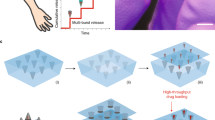ABSTRACT
Purpose
The purpose of this work is to demonstrate the feasibility of using a proprietary technology called MicroCor™, based on solid-state, biodegradable microstructures (SSBMS), for transdermal delivery of macromolecules.
Methods
The proteins FITC-BSA (66 kDa) and recombinant protective antigen (rPA; 83 kDa) were incorporated into SSBMS arrays using a mold-based, liquid formulation casting and drying process. Arrays were applied to the skin with a custom applicator and then inspected to assess the extent of microstructure dissolution. In vitro FITC-BSA delivery to human cadaver skin was visualized using light and fluorescence microscopy and quantified by extracting and measuring the fluorescently labeled protein. rPA-containing SSBMS arrays were applied in vivo to Sprague-Dawley rats. The resulting serum IgG response was measured by ELISA and compared with responses elicited from intramuscular (IM) and intradermal (ID) routes of administration.
Results
FITC-BSA and rPA SSBMS arrays successfully penetrated the skin. Microstructure dissolution was observed over >95% of the array area and >75% of the microstructure length. FITC-BSA delivery correlated with protein content in the formulations. Antibody titers after transdermal delivery of rPA were comparable or higher than IM and ID titers.
Conclusions
Transdermal delivery of macromolecules can be conveniently and effectively accomplished using the MicroCor technology.







Similar content being viewed by others
Abbreviations
- SSBMS:
-
solid-state biodegradable microstructures
- FITC-BSA:
-
fluorescein isothiocyanate—bovine serum albumin
- rPA:
-
recombinant protective antigen (ex. Bacillus anthracis)
- ID:
-
intradermal
- IM:
-
intramuscular
- IgG:
-
immunoglobulin G
- PET:
-
polyethylene terephthalate
REFERENCES
Prausnitz MR. Microneedles for transdermal drug delivery. Adv Drug Deliv Rev. 2004;56:581–7.
McAllister DV, Wang PM, Davis SP, Park JH, Canatella PJ, Allen MG, et al. Microfabricated needles for transdermal delivery of macromolecules and nanoparticles: Fabrication methods and transport studies. Proc Natl Acad Sci U S A. 2003;100:13755–60.
Matriano JA, Cormier M, Johnson J, Young WA, Buttery M, Nyam K, et al. Macroflux microprojection array patch technology: A new and efficient approach for intracutaneous immunization. Pharm Res. 2002;19:63–70.
Wang PM, Cornwell M, Hill J, Prausnitz MR. Precise microinjection into skin using hollow microneedles. J Invest Dermatol. 2006;126:1080–7.
Xie Y, Xu B, Gao Y. Controlled transdermal delivery of model drug compounds by MEMS microneedle array. Nanomedicine. 2005;1:184–90.
Teo MA, Shearwood C, Ng KC, Lu J, Moochhala S. In vitro and in vivo characterization of MEMS microneedles. Biomed Microdevices. 2005;7:47–52.
Rajaraman S, Henderson HT, Rajaraman S, Henderson HT. A unique fabrication approach for microneedles using coherent porous silicon technology. Sens Actuators B Chem. 2005;105:443–8.
Zahn JD, Deshmukh A, Pisano AP, Liepmann D. Continuous on-chip micropumping for microneedle enhanced drug delivery. Biomed Microdevices. 2004;6:183–90.
Draize JH. Methods for the study of irritation and toxicity of substances applied topically to the skin and mucous membranes. J Pharmacol Exp Ther. 1944;83:377–90.
Little SF, Ivins BE, Fellows PF, Pitt ML, Norris SL, Andrews GP. Defining a serological correlate of protection in rabbits for a recombinant anthrax vaccine. Vaccine. 2004;22:422–30.
Henderson EA, Louie TJ, Ramotar K, Ledgerwood D, Hope KM, Kennedy A. Comparison of higher-dose intradermal hepatitis B vaccination to standard intramuscular vaccination of healthcare workers. Infect Control Hosp Epidemiol. 2000;21:264–9.
Alarcon JB, Hartley AW, Harvey NG, Mikszta JA. Preclinical evaluation of microneedle technology for intradermal delivery of influenza vaccines. Clin Vaccine Immunol. 2007;14:375–81.
Belshe RB, Newman FK, Wilkins K, Graham IL, Babusis E, Ewell M, et al. Comparative immunogenicity of trivalent influenza vaccine administered by intradermal or intramuscular route in healthy adults. Vaccine. 2007;25:6755–63.
ACKNOWLEDGMENTS
The authors would like to acknowledge Appala Sagi, Danir Bairamov, Mikhail Shapiro, Creag Trautman, and Wade Worsham of Corium International, Inc. for fabrication of the SSBMS arrays and design of the custom impactor device. The authors would also like to gratefully acknowledge Raymond Daynes of the University of Utah for helpful discussions and technical assistance with executing the immunization studies.
Author information
Authors and Affiliations
Corresponding author
Rights and permissions
About this article
Cite this article
Wendorf, J.R., Ghartey-Tagoe, E.B., Williams, S.C. et al. Transdermal Delivery of Macromolecules Using Solid-State Biodegradable Microstructures. Pharm Res 28, 22–30 (2011). https://doi.org/10.1007/s11095-010-0174-y
Received:
Accepted:
Published:
Issue Date:
DOI: https://doi.org/10.1007/s11095-010-0174-y




